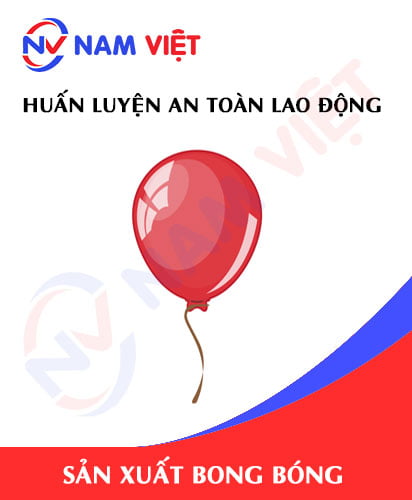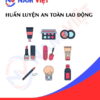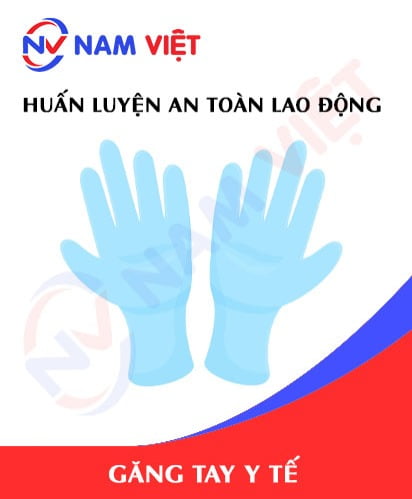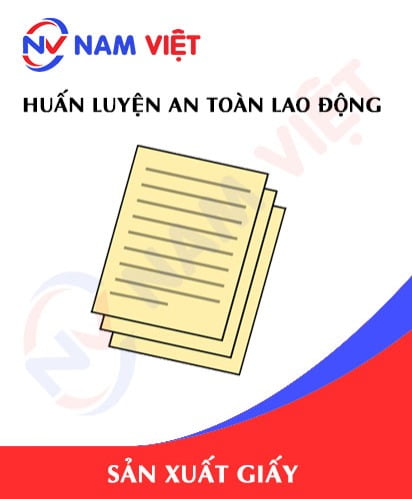Occupational Safety Training for Balloon Manufacturing
99,000 ₫
Note: The above price is calculated for one person, the price may fluctuate depending on the number of trainees attending the course and market movements. For more accurate pricing support, please refer to the price list or contact our consulting staff directly.
Occupational safety is an important issue in factory manufacturing balloons and needs to be addressed promptly to ensure the health and safety of workers, as well as enhance the reputation of businesses. The Occupational Safety Training course is one of the effective solutions to raise awareness of how to prevent workplace accidents for employees participating in balloon manufacturing.
Table of Contents
Toggle1. Overview of balloons
a. What is a balloon?
- Balloons (also called air balloons) are a type of ball made from materials such as rubber, plastic, or film, inflated with gas so they can float in the air. Balloons are often used at birthday parties, festival events, for advertising, or in decorative activities. Balloons can be inflated with regular air or helium gas to last for a longer period. When a balloon is punctured or runs out of gas, it will be destroyed and cannot be reused.
- The balloon manufacturing industry in Vietnam has developed recently. Vietnamese balloon manufacturing businesses not only supply products to the domestic market but also export to many markets around the world such as the United States, Japan, South Korea, Europe, the Middle East, and Southeast Asia…
- The strength of the balloon manufacturing industry in Vietnam is its diversity in types and designs, meeting the increasing demands of customers. In addition, due to lower manufacturing costs in Vietnam compared to other countries, the balloons produced here have competitive prices on the international market.
- However, the balloon manufacturing industry also faces many challenges such as increasingly strong competitors and difficulties in updating new technology to increase productivity and product quality.

b. Types of balloon manufacturing machinery
The types of balloon manufacturing machinery and equipment include:
- Plastic extruder machine: used to extrude plastic powder into plastic pellets suitable for balloon manufacturing specifications.
- Balloon press machine: used to press balloons and create different shapes.
- Balloon cutting machine: used to cut balloons into different sizes and shapes.
- Balloon printing machine: used to print images and text on balloons.
- Gas pump machine: used to pump gas into balloons to create inflation.
- Gas inspection machine: used to check the amount of gas in balloons and ensure product quality.
- Packaging machine: used to package balloons and prepare them for transportation and consumption.

c. Typical balloon manufacturing businesses
Currently, there are many balloon manufacturing businesses in Vietnam. Below are some typical businesses:
- Bong Bong Xinh Trading and Service Co., Ltd.
- Bong Bong Sai Gon Co., Ltd.
- Bong Bong Anh Duong Co., Ltd.
- Nhat Tien Manufacturing Trading Service Co., Ltd.
- Bong Bong Viet Nam Co., Ltd.
- Khoen Mau Manufacturing Trading Service Co., Ltd.
- Ngoc Thanh Balloon Trading and Service Co., Ltd.
These are some reputable businesses in the field of balloon manufacturing in Vietnam.
d. Specific jobs in a balloon manufacturing factory
Group 1
- Executive director, deputy executive director, department head in a balloon manufacturing factory.
Group 2
- Safety officer: manages safety in the factory, designs safety procedures, supervises and urges employees to comply with safe work procedures.
Group 3
- Raw material preparation: this is the stage of preparing the necessary raw materials for balloon manufacturing such as balloon solution, chemicals, tools, and packaging materials.
- Chemical mixing: mixing chemicals to create a balloon solution. The main chemicals often used include distilled water, soap, glycerin, sorbitol, and foaming agents.
- Mixing and shaping: After the balloon solution is mixed, we will mix in coloring agents, fragrances, and other additives. Then, the solution will be put into molds to shape the balloons into different shapes and sizes.
- Balloon inflation: After putting the balloon solution into the mold, workers will begin to inflate the balloons by using an air blower or blowing by hand.
- Inspection and packaging: After production is complete, balloons will be carefully inspected to ensure product quality and safety. Then, the balloons will be packaged and prepared for transportation to customers.
Group 4
- Office work, serving, sales, marketing.
- Production management, quality management, human resource management, material management, financial accounting management.
- Research and development of new products, design of product packaging.

2. Overview of labor safety training course for balloon manufacturing
Within the scope of this article, we focus on issues related to Group 3, because Group 3 is the group directly involved in the manufacturing process, bearing the highest risk of labor safety. See more about other groups here
a. What is Group 3 labor safety training?
- Labor safety training for Group 3 is a series of lessons that equip employees with awareness of how to prevent occupational accidents.
- The labor safety training course will help employees recognize and avoid dangers, and limit the risks of occupational accidents during work.
REGISTER FOR LABOR SAFETY TRAINING SERVICE
b. Training duration
Initial safety training duration
- The total training duration is at least 24 hours, including the test time.
- 8 hours of theoretical study on the system of policies and laws on occupational safety and hygiene
- 8 hours of theoretical study on basic knowledge of occupational safety and hygiene
- 4 hours of theoretical study on specialized training content
- 2 hours of practical training on specialized training content
- 2 hours of theoretical test at the end of the training course
The safety training center will divide the time into many training sessions depending on the time arrangement for the staff. But usually, there will be 6 training sessions, and the course will take place over 3 days, provided that the manufacturing business can arrange continuous study time.
Periodic safety training duration
- Before the labor safety card expires, employees who want to have it reissued must undergo a periodic labor safety training course, with the periodic safety training duration being at least 50% of the initial safety training duration.
Explanation: the total periodic labor safety training duration is at least 12 hours, including the test time. After completing the periodic training course and passing the test, the employee will be reissued, and the labor safety card will be extended.
c. Content of the training course
| No. | TRAINING CONTENT | TRAINING DURATION (HOURS) | |||
| Total | Of which | ||||
| Theory | Practice | Test | |||
| I | System of policies and laws on occupational safety and hygiene | 8 | 8 | 0 | 0 |
| 1 | Overview of the system of legal documents on occupational safety and hygiene. | 6 | 6 | ||
| 2 | System of technical standards and regulations on occupational safety and hygiene. | 1 | 1 | ||
| 3 | Specific regulations of state management agencies on occupational safety and hygiene when building new, expanding, or renovating works, facilities for manufacturing, using, preserving, storing, and inspecting machinery, equipment, materials, and substances with strict requirements for occupational safety and hygiene. | 1 | 1 | ||
| II | Basic knowledge of occupational safety and hygiene | 8 | 8 | 0 | 0 |
| 1 | Basic knowledge of dangerous and harmful factors at the workplace. | 4 | 4 | ||
| 2 | Methods to improve working conditions. | 1 | 1 | ||
| 3 | Safety culture in production and business. | 1 | 1 | ||
| 4 | Rights and obligations of the employer, employee; policies, regulations on occupational safety and hygiene for employees; functions and duties of the occupational safety and hygiene network. | 1 | 1 | ||
| 5 | Occupational safety and hygiene regulations, safety signs and instructions, and the use of safety equipment, personal protective equipment; professional skills, first aid for occupational accidents, prevention of occupational diseases. | 1 | 1 | ||
| III | Specialized training content | 6 | 4 | 2 | 0 |
| General knowledge of types of machinery, equipment, substances that generate dangerous and harmful factors; analysis, assessment, management of risks regarding occupational safety and hygiene, safe working procedures with machinery, equipment, and substances with strict requirements for occupational safety and hygiene. | 6 | 4 | 2 | ||
| IV | Testing the safety training content at the end of the training course | 2 | 2 | 0 | 0 |
| Total | 24 | 22 | 2 | ||
See more training content of 6 groups
d. Labor safety card
After completing the labor safety training course and passing the test, the employee will be issued a labor safety card (also commonly known as a Group 3 labor safety certificate ).
The Group 3 safety card will clearly show information such as: full name, date of birth, specific job and work environment. It will also have the training duration, a red stamp, and a signature confirming the completion of the training course.
According to the regulations for issuing safety cards specified in clause 2 Article 24 of Decree 44/2016/ND-CP, it is divided into 2 cases:
- In the case that the employer and the employee have a labor contract with each other, the employer must sign, stamp, and apply a seal on the safety card for the trained person in Group 3 after undergoing the training course from a labor safety training unit and passing the test.
- In the case of freelance or seasonal workers who do not have a labor contract, the training unit must sign, stamp, and apply a seal on the safety card for the employee after undergoing the training course from a labor safety training unit and passing the test.

3. Recognizing hazards in balloon manufacturing
Some hazards in balloon manufacturing include:
- The use of electrical equipment such as presses, balloon blowers, cutting machines, and balloon adhesives requires electrical safety measures to avoid the risk of electric shock.
- During the balloon manufacturing process, chemicals and flammable gases such as LPG or butane are used to inflate balloons and for balloon adhesives. Fire and explosion prevention measures are needed to ensure the safety of employees and the factory.
- Chemicals used in the balloon manufacturing process, such as adhesives, solvents, and coloring agents, can be harmful to health if not used correctly. Safety measures are needed for the use, storage, and disposal of chemical waste.
- Balloon manufacturing requires special skills and craftsmanship such as cutting, pressing, and blowing balloons. Employees need to be trained and safety equipment must be ensured to avoid the risk of injury.
- The use of machinery in balloon manufacturing can cause loud noise, which can be harmful to employees’ hearing. Ear protection measures are needed to ensure the health and safety of employees.
4. Common occupational accidents in balloon manufacturing
Common types of occupational accidents in balloon manufacturing include:
- Fire and explosion: During balloon manufacturing, propane or butane gas is often used to create hot vapor to inflate balloons. If not used and stored correctly, these gases can cause fires and explosions.
- Arbitrary dismantling and repairing of equipment: Workers who are not trained or do not have experience often do not know how to properly use and maintain machinery and equipment in the factory, leading to the risk of occupational accidents.
- Cuts or punctures to the hand with a knife or sharp object: When cutting balloons, workers must use knives or other cutting tools, leading to the risk of cuts and injuries.
- Burns: During the process of spraying hot vapor into balloons, workers can get burned if they do not wear full protective gear such as masks, long sleeves, and heat-resistant gloves.
- Other accident injuries: In addition to the above occupational accidents, workers can also encounter other accidents such as falls, slips, and collisions during their work in the balloon manufacturing factory.
5. Safety measures when participating in balloon manufacturing
Safety measures when participating in balloon manufacturing include:
- Fully use personal protective equipment such as helmets, safety glasses, gloves, fire-resistant jackets, special shoes…
- Follow the correct procedures and technical instructions for balloon manufacturing to avoid accidents due to negligence or technical errors.
- Regularly inspect and maintain manufacturing equipment and machinery to ensure they are working well and safely.
- Use materials and chemicals with a clear origin, do not use materials or chemicals that contain toxic or explosive substances.
- Store products containing flammable gases in a dry, cool place, away from fire and other explosive agents.
- Have a fire prevention and firefighting plan and firefighting equipment ready to handle fire and explosion incidents in a timely manner.
- Provide labor safety training for employees, providing knowledge about risks and fire prevention, firefighting, and first aid measures for workers and staff during work.
- Strictly control the use of equipment containing flammable gases, especially in environments with a risk of explosion, to ensure they are not impacted, collided with, or exposed to other explosive agents.
- Install a ventilation system to ensure air circulation and create a safe working environment.
- Comply with environmental protection regulations, ensuring no pollution to the surrounding environment.
- Periodically organize work environment monitoring in factories and enterprises, collect and analyze harmful factors for workers, thereby adjusting to reduce the level of harm to prevent occupational diseases for them.

6. Benefits of labor safety training for balloon manufacturing
An Toan Nam Viet provides businesses with great benefits after completing labor safety training courses as regulated in Decree 44/2016/ND-CP on occupational safety and hygiene for companies, factories, and businesses.
- Employees can recognize potential risks of occupational accidents and thus have preventive measures to avoid them.
- Businesses can establish risk prevention measures in production, operation, and maintenance processes.
- Reduce costs when safety risks occur in labor.
- Uninterrupted production processes will help increase labor productivity and product quality.
- Comply with labor safety laws, avoiding legal risks.
- Create prestige and professionalism in all aspects, thereby elevating the brand for your business.
Nam Viet’s training courses are a solution to prevent and combat external factors that can lead to danger for each individual, helping them avoid injuries or, more seriously, death.
REGISTER FOR LABOR SAFETY TRAINING SERVICE
7. Customer feedback after completing the labor safety training course for balloon manufacturing
An Toan Nam Viet has many years of experience in the mission of accompanying many businesses in Vietnam in general and in the southern provinces in particular. And this responsibility is something extremely precious to Nam Viet, which is why Nam Viet’s Labor Safety Training work is always focused on becoming more and more professional. And the motivation for An Toan Nam Viet to grow strongly to this day comes from the positive feedback and suggestions from businesses. Below are the feedback from our partners we have served.
Bac Nam E&C Construction Investment Joint Stock Company
“The first time I used the service at An Toan Nam Viet, I was very surprised by the enthusiastic 24/7 support of the consulting team. The class organization was very quick and convenient for our company, thank you very much for Nam Viet’s service!”
Hoa Dat Construction and Trading Joint Stock Company
“Nam Viet’s service has helped us a lot in simplifying labor safety and completing safety records for our work process. The consulting team is enthusiastic and timely in answering our questions. 5 stars for Nam Viet”
See more customer interviews after using An Toan Nam Viet’s service
8. An Toan Nam Viet’s Labor Safety Training capacity
An Toan Nam Viet is a reputable and quality labor safety training center in Vietnam today. With labor safety training sessions taking place continuously at manufacturing workshops, factories, or construction sites across the country (63 provinces and cities in Vietnam).
REGISTER FOR LABOR SAFETY TRAINING SERVICE
License for labor safety training
- An Toan Nam Viet has been inspected and granted a certificate of eligibility to operate in occupational safety and hygiene training by the Safety Department of the Ministry of Labor – Invalids and Social Affairs. This further strengthens our capacity to conduct labor safety training.

Materials and lectures
- Before labor safety training materials are put into OSHE training courses, they are reviewed and censored to ensure that the lectures are correct in terms of knowledge and effective when applied.
- The teaching methods of the lecturers are synchronized according to An Toan Nam Viet‘s teaching standards, which are methods that experts on occupational safety and hygiene training have researched and summarized during the teaching process to bring the highest knowledge absorption efficiency to students.
Facilities
- Controlling the factors in the classroom that affect the training process will increase teaching efficiency and knowledge absorption efficiency for students.
- Our training course support facilities always arrange spacious classrooms that meet standards for area, lighting, training equipment, etc.
9. Reputable and quality safety training center nationwide
At An Toan Nam Viet, we always prioritize the professional dedication to labor safety training. For us, imparting the knowledge to protect oneself to workers so they can have a safe foundation on their path to earning a living is contributing to building the country.
To ensure effective training, we carefully and meticulously prepare every single detail, no matter how small. From preparing tools, equipment, teaching aids to curricula, materials, sound, and lighting.
Our labor safety training lecturers are experts with many years of experience in the field. They even have research projects on identifying hazards in all occupations and how to prevent them.
The lecturers’ lectures are summarized from practical experience and conveyed in a vivid and easy-to-understand way to workers. These factors help workers feel comfortable during their study time and absorb our teaching knowledge well. Of course, the knowledge conveyed always closely follows Decree 44/2016/ND-CP.
From there, they grasp many measures to prevent danger and how to protect themselves. At the same time, they also apply it in the most appropriate way in their actual work.
Our safety training center is proud to be a reputable and professional provider of labor safety training services with the following advantages:
- Competitive training costs but training quality is still guaranteed.
- Flexible training schedule to suit the production situation of the company.
- Fast and legally compliant procedures for issuing labor safety training certificates.
- Lecturers are experienced professionals with many years in the profession.
- The classroom environment is controlled for factors that affect the training process, increasing teaching efficiency and knowledge absorption effectiveness for students.
- Lectures are compiled to suit the labor safety work at businesses.
- An Toan Nam Viet works with dedication and professionalism to support customers accurately and quickly.

10. Refer to more labor safety training documents for balloon manufacturing
- Labor safety documents for balloon manufacturing
- Set of labor safety training documents
- Set of labor safety training test questions
- Multiple-choice test for labor safety in balloon manufacturing
- Slides for labor safety training lecture on balloon manufacturing
1 review for Occupational Safety Training for Balloon Manufacturing
No comments yet















namchinh.haiphong341
cảm trung tâm rất nhiều